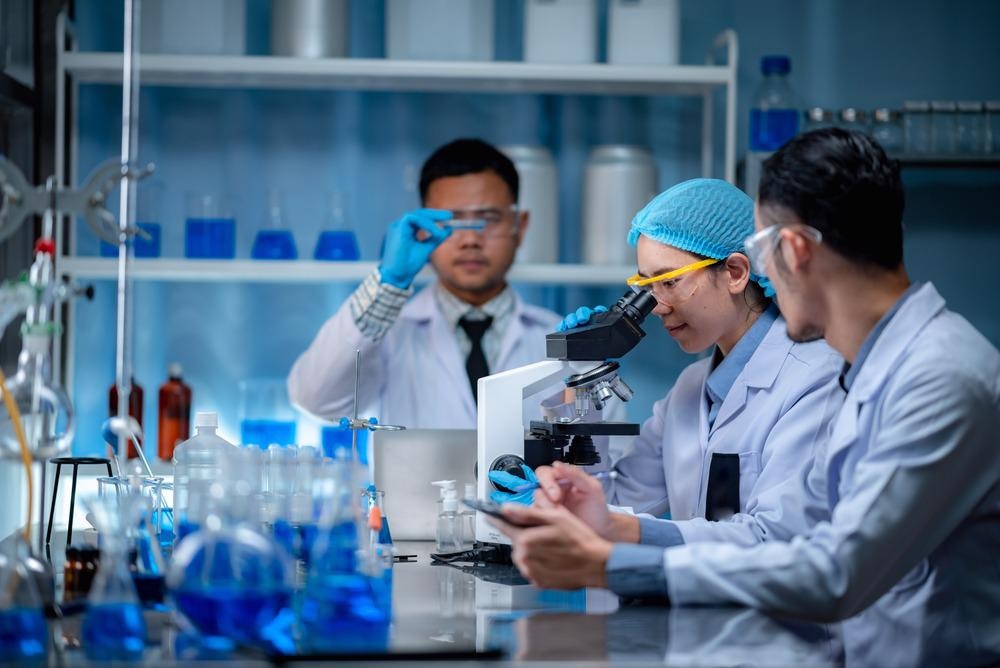In a research paper published in the journal Materials Science & Engineering: C, a group of researchers investigated the effects of gold nanoparticles (Au-NPs) synthesized in situ on electrospinning nanofiber scaffolds on the neurological development of stem cells.

Study: Influence of reducing agents on in situ synthesis of gold nanoparticles and scaffold conductivity with emphasis on neural differentiation. Image Credit: Chokniti Khongchum/Shutterstock.com
Although advances in nerve tissue regeneration have yet to provide satisfying results, and full physiological restoration is not guaranteed, nanofibers scaffolds offer an excellent foundation for stem cell transplantation by managing cell growth to restore lost cells.
What is Tissue Engineering?
Nerve tissue damage-related events are becoming more prominent health problems that have had a significant influence on people's health. Tissue engineering has received attention as a viable strategy for nerve regeneration, and nerve tissue engineering necessitates a scaffold with bioactivity, elasticity, regulated biodegradable characteristics, and permeability for cellular proliferation and vascularization.
Other characteristics of a scaffold ideal for nerve regeneration include non-cytotoxic breakdown products and adequate mechanical qualities to prevent structural deterioration.
Conductive scaffolds have also been shown to offer axonal regrowth and neural development, thanks to the fast advancement of nerve tissue engineering. Even though several kinds of conductive scaffolds can regenerate nerves, these therapies have not been successful in the majority of instances and have experienced difficulties. To put this in context, the conductance threshold of scaffolds, which provide substantial assistance for growth and regeneration, is a major issue.
Fabrication of Tissue Engineering Scaffolds
Electrospinning is a typical approach for fabricating tissue engineering scaffolds because it creates a nano-sized structure as active as the extracellular matrix for cellular transformation. Also, Polycaprolactone (PCL) is a sustainable polyester that has been authorized by the FDA.
PCL with chitosan enhances chitosan's processing and physical capabilities while also addressing PCL's biological and hydrophilic constraints. As a result, the PCL/CS combination may be a good candidate for electron-spun nanofibrous scaffold production.
Insertion of Au-NPs into Scaffolds
Electrical conductivity has been shown to positively impact cell reproduction and nerve regeneration, and several kinds of conductive scaffolds have been tested to improve nerve regeneration at damage sites.
The insertion of Au-NPs into polymeric scaffolds to induce electrical conductivity is of interest owing to Au-NPs' unique optoelectronic capabilities, as well as their significant biological stability.
Au-NPs have been used in a variety of biological applications, including drug administration, photothermal treatments, and detection/imaging. Because of their facile production, large specific area ratio, and ability to adhere chemical munitions to the surface, Au-NPs are well suited for employment in biological systems.
To enhance the extent of Au+ reduction and electrical conductivity of the PCL/CS nanofiber scaffold, researchers employed THPC and formaldehyde compounds that were incorporated inside the nanofibers scaffold during electrospinning.
Research Findings
The researchers developed PCL-based scaffolds with CS and Au-NPs under various settings for their research. The shape of the nanofibrous scaffolds did not alter significantly after adding Au ions and synthesizing Au-NPs in situ. Incorporating Au ions into electrospinning solutions, however, reduced the average diameter of fibers.
The production of hemispheric Au-NPs on the fibers was demonstrated by FE-SEM images. The conductivity of composite scaffolds made with THPC for four days and formaldehyde for seven days was found to be within the range of acceptable electrical conductivity for tissue repair.
In vitro tests revealed that the scaffolds could proliferate more than the control condition, and cell viability results revealed that the Au-NPs-contained PCL/CS scaffolds generated with formaldehyde resulted in increased proliferation of fiber cells at all durations than the other groups. This conductive scaffold's ability to grow MSCs into neuron-like cells was also confirmed.
Conclusion
To conclude, the constructed scaffolds demonstrated the ability to be used in future biological applications.
They may also be used as a route for delivering neurotrophic factors and controlling their release. More research is required to determine precise mechanisms of how the rate of degradation and biodegradable waste impact the destiny of neural cells when this kind of scaffold is used as a carrier for metabolic factors for the nervous system.
Continue reading: Gold Nanoparticles in Mass Spectrometry: Enabling Neurological Research.
Reference
Rahimzadegan, M. et al. (2021). Influence of reducing agents on in situ synthesis of gold nanoparticles and scaffold conductivity with emphasis on neural differentiation. Materials Science and Engineering: C. Available at: https://www.sciencedirect.com/science/article/abs/pii/S0928493121007748
Disclaimer: The views expressed here are those of the author expressed in their private capacity and do not necessarily represent the views of AZoM.com Limited T/A AZoNetwork the owner and operator of this website. This disclaimer forms part of the Terms and conditions of use of this website.